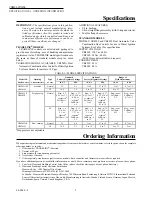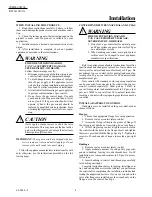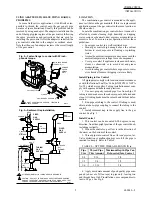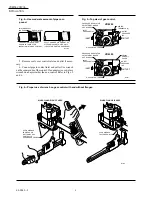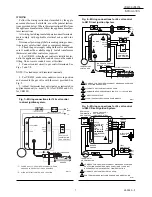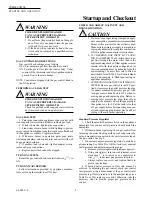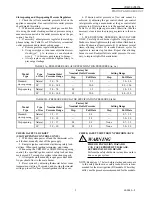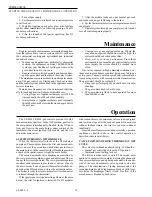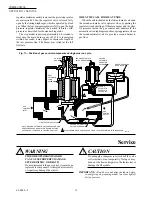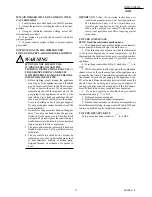
68-0049—2
8
VR8205; VR4205
STARTUP AND CHECKOUT
Startup and Checkout
!
WARNING
FIRE OR EXPLOSION HAZARD
CAN CAUSE PROPERTY DAMAGE,
SEVERE INJURY OR DEATH
1. Do not force the gas control knob on the appli-
ance. Use only your hand to turn the gas con-
trol knob. Never use any tools.
2. If the knob will not operate by hand, the con-
trol should be replaced by a qualified service
technician.
GAS CONTROL KNOB SETTINGS
Gas control knob settings are as follows:
OFF: Prevents main gas flow through the control.
ON: Permits gas to flow into the control body. Under
control of the thermostat and direct ignition module,
gas can flow to the main burner.
NOTE: Controls are shipped with the gas control knob in
the ON position.
PERFORM GAS LEAK TEST
WARNING
FIRE OR EXPLOSION HAZARD
CAN CAUSE PROPERTY DAMAGE,
SEVERE INJURY OR DEATH
Check for gas leaks with soap and water solution
any time work is done on a gas system.
GAS LEAK TEST
1. Paint pipe connections upstream of gas control with
rich soap and water solution. Bubbles indicate gas leak.
2. If leak is detected, tighten pipe connections.
3. Stand clear of main burner while lighting to prevent
injury caused from hidden leaks that could cause flashback
in the appliance vestibule. Light main burner.
4. With main burner in operation, paint pipe joints
(including adapters) and control inlet and outlet with rich
soap and water solution.
5. If another leak is detected, tighten adapter screws,
joints, and pipe connections.
6. Replace part if leak cannot be stopped.
TURN ON SYSTEM
Rotate the gas control knob counterclockwise
to
ON.
TURN ON MAIN BURNER
Follow instructions provided by appliance manufac-
turer or turn up thermostat to call for heat.
!
CHECK AND ADJUST GAS INPUT AND
BURNER IGNITION
CAUTION
1. Do not exceed input rating stamped on appli-
ance nameplate, or manufacturer recommended
burner orifice pressure for size orifice(s) used.
Make certain primary air supply to main burner
is properly adjusted for complete combustion.
Follow appliance manufacturer instructions.
2. IF CHECKING GAS INPUT BY CLOCK-
ING GAS METER. Make certain there is no
gas flow through the meter other than to the
appliance being checked. Other appliances must
remain off with their pilots extinguished (or
their consumption must be deducted from the
meter reading). Convert flow rate to Btuh as
described in form 70-2602, Gas Controls Hand-
book, and compare to Btuh input rating on
appliance nameplate.
3. IF CHECKING GAS INPUT WITH MANO-
METER: Be sure gas control is in OFF posi-
tion before removing outlet pressure tap plug
to connect manometer (pressure gauge). Also
turn gas control knob back to OFF when re-
moving gauge and replacing plug. Before re-
moving inlet pressure tap plug, shut off gas
supply at the manual valve in the gas piping to
the appliance or, for LP, at the tank. Also shut
off gas supply before disconnecting manom-
eter and replacing plug. Repeat Gas Leak Test
at plug with main burner operating.
Standard Pressure Regulator
1. Check the manifold pressure listed on the appliance
nameplate. Gas control outlet pressure should match the
nameplate.
2. With main burner operating, check gas control flow
rate using the meter clocking method or check pressure by
using a manometer connected to the outlet pressure tap on
the gas control. See Fig. 5.
3. If necessary, adjust pressure regulator to match ap-
pliance rating. See Table 5A or 5B for factory set nominal
outlet pressure and adjustment setting range.
a. Remove pressure regulator adjustment cap screw.
b. Using screwdriver, turn inner adjustment screw
clockwise
to increase or counterclock-
wise
to decrease gas pressure to burner.
c. Always replace cap screw and tighten firmly to
prevent gas leakage.
4. If desired outlet pressure or flow rate cannot be
achieved by adjusting the gas control, check gas control
inlet pressure using a manometer at the gas control inlet
pressure tap. If inlet pressure is in the nominal range (see
Table 5A or 5B), replace gas control. Otherwise, take the
necessary steps to provide proper gas pressure on the
control.
!


